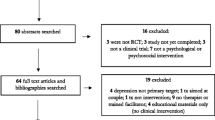Abstract
Despite a considerable number of studies, there are two major drawbacks in the literature on grief and bereavement. One is a lack of adequate and generally agreed upon measures for assessing grief. The second is a lack of ability to predict from existing measures the likelihood of what has been termed “chronic” or “pathological” grief reactions. This paper reports the results of the development of a bereavement measure for the study of perinatal loss which attempts to address these gaps. The measure is specific to a pregnancy-related loss, although it has the potential for adaptation to use for other types of loss. Analysis of responses from 138 women has resulted in the reduction of the original measure from 104 to a more manageable and almost equally comprehensive and reliable 33 items. In addition, a factor analysis has produced three factors, two of which indicate the possibility for longer-term and more severe grief reactions. Because of its sound psychometric qualities and interesting factor structure, the measure shows promise of being useful for both research and clinical purposes.
Similar content being viewed by others
References
Benfield, G., Leib, S., & Volman, J. (1978). Grief response of parents to neonatal death and parent participation in deciding care.Pediatrics, 62, 171–177.
Blanchard, C. G., Blanchard, E. B., & Becker, J. V. (1976). The young widow: Depressive symptomatology throughout the grief process.Psychiatry, 39, 384–399.
Bugen, L. A. (1977). Human grief: A model for prediction and intervention.American Journal of Orthopsychiatry, 42, 196–206.
Campbell, D. T., & Stanley, J. (1963).Experimental nd Quasi-Experimental and Quasi-Experimental Designs for Research. Chicago: Rand McNally College.
Clayton, P. J., Desmarais, L., & Winokur, G. (1968). A Study of normal bereavement.American Journal of Psychiatry, 125, 168–178.
Cullberg, J. (1971). Mental reactions of women to perinatal death.Psychosomatic Medicine in Obstetrics and Gyneocology, 326–329.
Derogatis, L. R., Rickels, K., & Rock, A. F. (1976). The SCL-90 and MMPI: A stop in the validation of a new self-report scale,British Journal of Psychiatry, 128, 280–289.
Forrest, G. C., Standish, E., & Baum, J. D. (1982). Support after perinatal death: A study of support and counseling after perinatal bereavement.British Medical Journal, 285, 1475–1479.
Freud, S. (1917). Mourning and melancholia.The Complete Psychological Works of Sigmund Freud (Vol. 14). New York: W. W. Norton.
Jacobs, S., & Ostfeld, A. (1977). An epidemiological review of the mortality of bereavement.Psychosomatic Medicine, 39, 344–357.
Kennell, J. H., Slyter, H., & Klaus, M. H. (1970). The mourning response of parents to the death of a newborn infant.New England Journal of Medicine, 283, 344–349.
Kirkley-Best, E. (1981). Grief in response to prenatal loss: An argument for the earlier maternal attachment. Unpublished doctoral dissertation. Gainesville: University of Florida.
Kirkley-Best, E., & Kellner, K. (1982). The forgotten grief: A review of the psychology of still-birth.American Journal of Orthopsychology, 52, 420–429.
Osterweis, M., Solomon, F., & Green, M. (Eds.), (1984).Bereavement: Reactions, Consequences, and Care. Washington, DC: National Academy Press.
Parkes, C. M., & Weiss, R. S. (1983).Recovery from Bereavement. New York: Basic Books.
Peppers, L. G., & Knapp, R. J. (1980). Maternal reactions to involuntary fetal/infant death.Psychiatry, 43, 155–159.
Sanders, C. M., Mauger, P. A., & Strong, P. N. (1985). A Manual forThe Grief Experience Inventory. Palo Alto, CA: Consulting Psychologists Press.
Toedter, L., Lasker, J., & Alhadeff, J. (1988). The Perinatal Grief Scale: Development and initial validation.American Journal of Orthopsychiatry, 58, 435–449.
Videka-Sherman, L., & Lieberman, M. (1985). The effects of self-help and psychotherapy intervention on child loss: The limits of recovery.American Journal of Orthopsychiatry, 55: 70–82.
Williams, W. V., & Polak, P. (1979). Follow-up research in primary prevention: A model of adjustment in acute grief.Journal of Clinical Psychology, 35, 35–45.
Zisook, S., Devaul, R. A., & Click, M. A. (1982). Measuring symptoms of grief and bereavement.American Journal of Psychiatry, 139, 1590–1593.
Author information
Authors and Affiliations
Additional information
This research was funded by National Institute of Child Health and Human Development Grant R01 H18431-04, with additional assistance from the Center for Social Research at Lehigh University. Dr. Potvin is supported by the Quebec Health Research Fund.
Rights and permissions
About this article
Cite this article
Potvin, L., Lasker, J. & Toedter, L. Measuring grief: A short version of the perinatal grief scale. J Psychopathol Behav Assess 11, 29–45 (1989). https://doi.org/10.1007/BF00962697
Accepted:
Issue Date:
DOI: https://doi.org/10.1007/BF00962697




